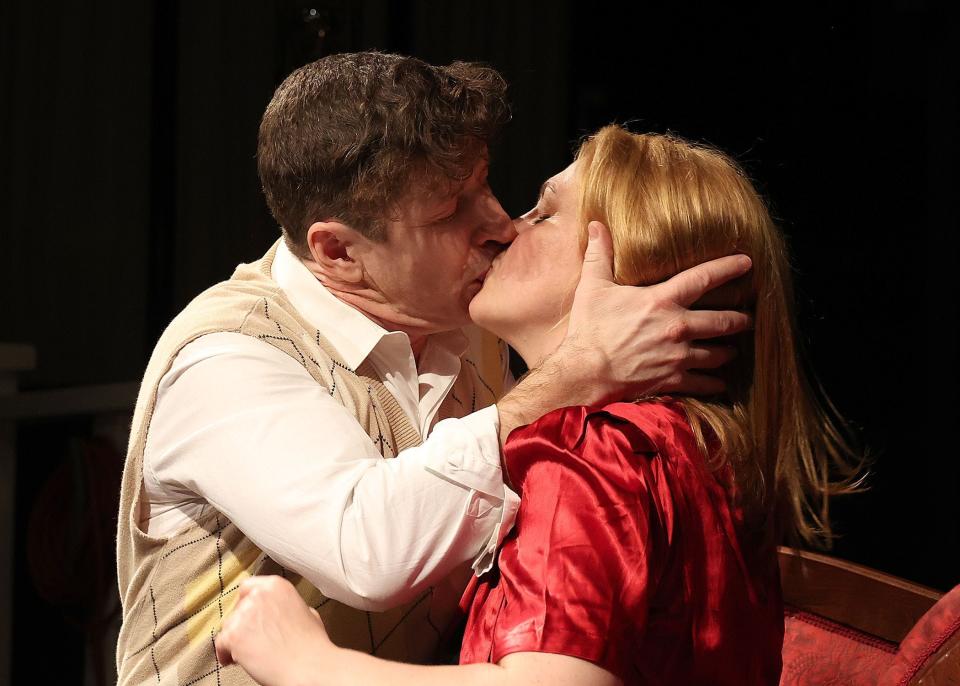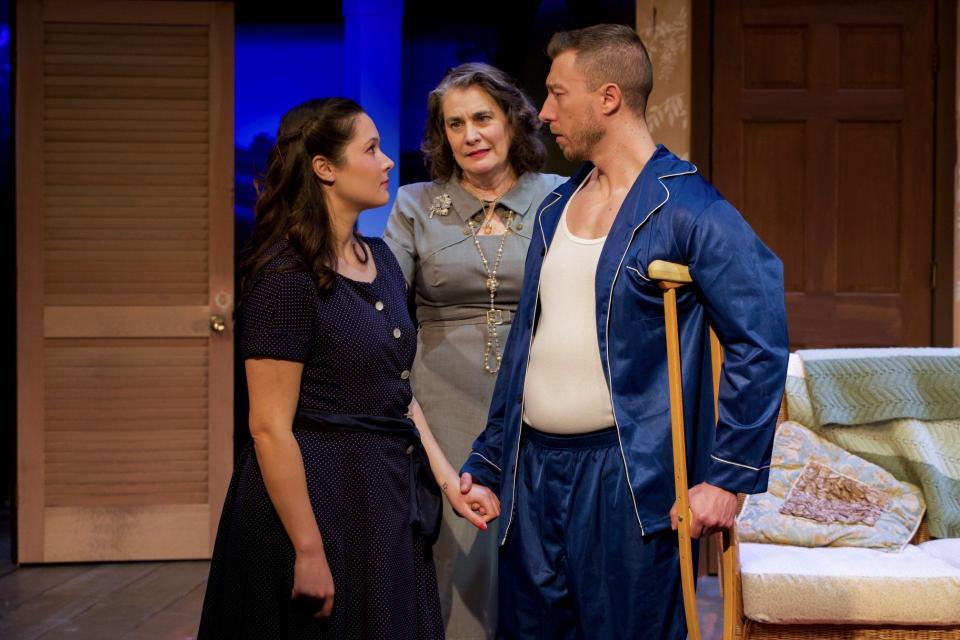Reviews: Emotions run high with 'Stage Kiss' & 'Cat on a Hot Tin Roof' in Orleans, Cotuit
- Oops!Something went wrong.Please try again later.
The Academy of Performing Arts in Orleans has sandwiched between two sweet treats — the recent “Cinderella” and the upcoming “Annie”— an offering that’s sharp, salty and savory, just for a change of pace. “Stage Kiss” is a close-up-and-personal look at the lives of struggling actors trying to manage their dedication to their craft and to each other. It is spiced with a dark humor and more than a touch of pathos. This is the kind of show that tests actors’ abilities to get messages across to the audience without overplaying their hands. In the end, it is filled with life lessons.

Have you ever wondered how actors feel when they have to feign affection and kiss onstage? This is a look at the mental gymnastics required when actors have to pucker-up. But, in the hands of playwright Sarah Ruhl, THE KISS is really just a symbol for the relationships actors build on- and off-stage.
The first of many “stage kisses” happens when Fred Carpenter as The Director, guides two actors — simply identified as SHE (Missy Potash) and Kevin (DJ Kostka) — in a kissing scene. This first smooch is (intentionally) a little awkward. It seems that Kevin, who notes that he is gay, is in unfamiliar territory.
But fear not! There are lots more kisses to come.
The show: "Stage Kiss,” written by Sarah Ruhl, directed by Rachel Hischak, presented by Academy of Performing Arts.
That becomes clear when HE (Eli Woods) enters the scene. We know from the start that HE and SHE have crossed paths and pressed lips together before, both on and off stage. There is a tension between them that is palpable, and it plays out throughout the varied and multiple kissing scenes.
But wait; there is also the long-suffering, saintly and well-heeled husband of SHE (Dan Rabold), who we learn is “in acquisitions and mergers.” (No wonder SHE is constantly looking for other lips to kiss!)
A multi-layered look at kissing
Highlights of the show: One of the things that makes this show interesting and unique is the multi-layered feel to the piece. There are scenes within scenes within scenes as the action switches from the characters’ “real lives” to various productions within the production. (It is a little challenging to be clear about where a scene is located in the complex geography of the show.)
Through it all, Potash is the constant, skillfully guiding the audience from one scene and layer to the next.
And peppered throughout is often-subtle humor that the opening-night audience appreciated. But in one of the shows-within-the-show, Kostka explodes on the scene as a pimp bent on gaining control of his “employee.” He is dressed in a bright-colored, satiny outfit that garners the biggest laugh of the night.
Go or No Go: Go for a unique night of theater. But be aware that this is not light fare. And note that the dialogue is peppered with four-letter words. If that offends you, you might want to skip this one.
If you go: 7 p.m. Thursdays, Fridays and Saturdays, through Feb. 24. Then 2 p.m. Sundays through Feb. 25. Academy of Performing Arts, Academy Theater, 120 Main St., Orleans, 508-255-1963, tickets $25-$35, www.academyplayhouse.org.
The show: "Cat on a Hot Tin Roof,” written by Tennessee Williams, directed by Jason Mellin, produced by Emma Hennessy and presented by Cotuit Center for the Arts.

The Cotuit Center for the Arts is offering on its Main Stage one of the tours de force of that master of drama, Tennessee Williams. “Cat on a Hot Tin Roof” takes a searing look at the impact of tragedy on a family in the once-grand Old South. It is a perfect example of the playwright’s ability to peer deeply into the souls of his characters, rendering them shattered and bare for his audiences to see. And the absolute genius of Williams is that through all the (figurative) bloodshed, he manages to weave threads of hope and redemption. Isn’t that the perfect portrait of the human condition?
What it's about:
The show opens on Brick (Elliott Sicard) and Maggie (Emma Hennessy) in their apartment in the Mississippi Delta estate of the Pollitts. (We eventually learn that patriarch Big Daddy, played by Christopher Cooley, has built the 28,000-acre empire from scratch.) Brick stands at a bar pouring one glass of whiskey after another, declaring that he is “looking for that click that makes me feel comfortable.”
Meanwhile Maggie, dressed in a silken negligee, wanders about the room verbally painting the picture of a woman scorned and suffering. She says to her husband, “You have devoted yourself to the occupation of drinking.” That misplaced devotion, she says, makes her feel desperately lost and alone. “Living with someone you love who doesn’t love you is so lonely,” she says. At one point she looks out at the audience, as if there were a mirror in front of her. (This is a particularly effective technique that tests an actor’s ability to paint a mental image for the audience. And it is a testament to both Hennessy and director Mellin that the audience “sees” the mirror.) At one point, Maggie addresses Brick’s mirror image saying, “Why do you look at me that way,” as Brick pours another drink.
In the corner of the apartment is a big bed. More than just a piece of furniture, this is a potent symbol of the wasteland that is the couple’s relationship. Maggie says of their now-dismantled physical relationship, “It was more like opening a door for a lady. You were indifferent to it.” Her frustration, she says, makes her feel like “a cat on a hot tin roof.” Brick answers, “Well just jump off.”
In the background is the sound of children, who Maggie dubs “no-neck monsters.” We eventually learn that the five no-necks’ parents — Brick’s brother and sister-law (Emma Fitzpatrick as Sister Woman Mae and Matt Gardner as Brother Man Gooper — are pretenders to the throne currently occupied by ailing Big Daddy. (While the emperor has yet to write a will, it becomes clear he longs to leave the holdings to favorites Brick and Maggie instead…if only Brick could ditch the bottle…)
The thermonuclear war that is the Pollitts’ family life is sure to lead to chaos and destruction. But in the hands of dramatic genius Williams, there may actually be a clearing in the end.
Highlights of the show:
This show is all about deeply-felt emotions and relationships and, in the hands of director Mellin, the actors clearly understand that. Importantly, we have a clear and immediate picture of the leads’ relationship. But supporting characters also give us access to their souls. Janet Geist Moore is especially effective and compelling as Big Mama, the fiery and feisty matriarch who has been treated as little more than an afterthought throughout her marriage to the king, Big Daddy. Cooley plays the role of Big Daddy with all the power and pomposity that Williams intended. Fitzpatrick and Gardner are suitably annoying and unlikable as the out-of-favor in-laws. Then there is the unseen and deceased character Skipper, who all the actors make clear is at the heart of the story. The question about the nature of his once intimate (maybe literally) relationship with Brick hangs in the air throughout.
Go or No Go: Go to peer into the tortured mind of one of the greatest dramatists of the last century. But keep in-mind that it is a serious piece filled with deep emotion and sexual references. It is certainly best suited to adult audiences.
Worth noting: Set designer Michael Ernst and his crew have created a set that, while mostly unadorned, features a background that makes it clear the apartment is in the Pollitts’ mansion.
One more thing: Williams spent a large part of his life on Cape Cod. In fact, he is rumored to have completed a number of pieces while in a rooming house in Provincetown.
If you go: 7:30 p.m. Thursday and Friday, 5 p.m. Saturday, and 2 p.m. Sunday Feb. 18. The Cotuit Center for the Arts, 4404 Falmouth Road, Cotuit, 508-428-0669, tickets: Starting at $35 for general admission, with a choose-your-own-price option for available seating starting at $10. Call the Center or to choose seating and view pricing go to www.artsonthecape.org.
Thanks to our subscribers, who help make this coverage possible. If you are not a subscriber, please consider supporting quality local journalism with a Cape Cod Times subscription. Here are our subscription plans.
This article originally appeared on Cape Cod Times: Reviews: Leave the kids home, lace up big kid books for two Cape plays

